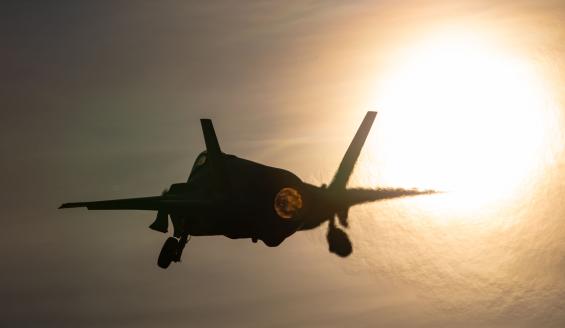Review of F-35 Programme’s Current Status

The year is ending and the commander of the Finnish Air Force changes at the turn of the month. In this article Major General Juha-Pekka Keränen, Commander of the Finnish Air Force, discusses the current status of the F-35 Programme and the aims of the capability introduction in the near future.
The F-35 Programme, a significant milestone for the Finnish Defence Forces (FDF), has advanced well in the past year. The first F-35A fighters of the Finnish Air Force (FINAF) are in production at Lockheed Martin and its partners, the construction of the F-35 infrastructure is underway and the Finnish Defence Forces have been authorised to supplement the F-35 weapons suite with missiles including JASSM-ER and AARGM-ER.
In autumn 2025, the F-35 initial training of Finnish personnel will begin in the United States with theory and simulator training courses in Eglin, Florida. Finland’s first F-35A, JF-501 (Joint Fighter), is to be handed over to the Air Force in a rollout ceremony in the end of autumn 2025. After this the FINAF will introduce its first fighters into service during the practical part of the F-35 initial training at Ebbing Air Base, Arkansas. The initial training is to be conducted with the first eight fighters as they roll off the assembly line.
At home the first Finnish F-35 fighters will be seen by the latter half of 2026. At that point, the FINAF will begin F-35 training domestically when the personnel trained in the United States start to provide conversion training for the F-35 system integration in Finland. The F-35 will achieve full operational capability (FOC) by the end of 2030.
Commander of the Finnish Air Force, Major General Juha-Pekka Keränen considers the F-35 capability integration to be in a good phase right now.
– The F-35 Programme overall has advanced as planned. I see no major obstacles ahead of us - on a large scale we’re doing well and I’m pleased with the progress of the programme.
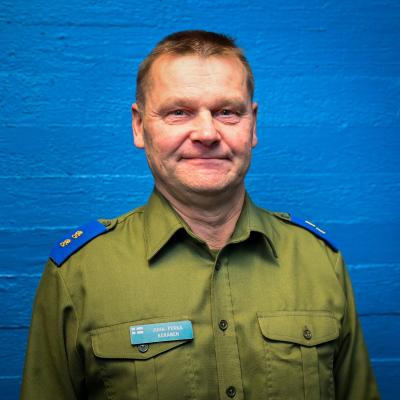
FINAF follows F-35 capability integration schedule closely.
– Our transition period from the Hornet to the F-35 is extremely tight, and we cannot afford to let it slip. The schedule is pretty packed and ambitious - in 2028 at Lapland Air Wing, the F-35 will be combat capable and the Hornet will no longer be flown there. If the introduction into service of the F-35 capability were delayed by for example a year or two, we wouldn’t achieve the F-35 operational capability in time and we’d have to decide what to do with the Hornet. It seems though that the schedule risk won’t materialise, which is a good thing. I’ve assured the commander of the Finnish Defence Forces that we are on schedule to meet the designated goals.

FINAF bases readying for F-35 operations
The Defence Forces prepares to operate the F-35 in Finland by devising detailed integration and operational plans, and by construction and changes made at the FINAF bases. Air base development for the F-35 capability integration is underway at all bases of the Air Force.
The F-35 prompts the construction of protection, maintenance, training and storage facilities as well as development of manoeuvring areas and airfield infrastructure. Moreover, FINAF control and command facilities will undergo changes as needed to meet the operational and safety requirements of F-35 operations, and in aviation industry, changes necessitated by security of supply concerns will be made. The goal is to update the facilities to meet the security demands of the 2030s. The FINAF operates from the same premises also in wartime and has to be prepared for an extended crisis when the need arises.
Thus far the air bases have seen erection of installations, blasting work, apron repairs and arresting gear systems required for F-35 operations. Apart from these, building will continue with the construction of new facilities and structures as well as any required area work and changes.
The FINAF commander emphasises the schedule’s importance also in the development of domestic infrastructure.
– The target completion dates of the F-35 infrastructure at FINAF bases are critically important to allow us to introduce the F-35 into service as scheduled. The deadline for having the F-35 simulator facilities of Lapland Air Wing ready is the early autumn 2026 in order to begin simulator training immediately after summer holidays.
Behind the construction and changes of F-35 infrastructure are
- Operational requirements of the FINAF: The infrastructure building and changes enhance the air bases’ combat resilience. With comprehensive development of the air bases, including the F-35 infrastructure projects, the Air Force will be able to operate the F-35 fleet as planned and in accordance with the Agile Combat Employment concept. The possibility to place all F-35 fighters under hard shelters as needed increases the combat resilience of the Air Force. Additionally, critical functions will be placed in protected facilities.
- National security of supply requirements: The F-35 Programme supports the national security of supply of the Finnish F-35 fleet by building national repair capacity in Finland as well as nationally controlled spare and replaceable component inventories for wartime.
- Security requirements of the F-35 Programme: The multinational F-35 Programme has distinct security requirements concerning physical safety and information security, whose purpose is to enable the operational safety of F-35 missions in all conditions. As a member of the F-35 user community, the FINAF adheres to the F-35 security measures, which can be seen for example as new facility security requirements and access restrictions to specific F-35 information. In practice, these measures can involve air base and facility monitoring and guarding, facility and installation planning, and information systems in use.
- Physical facilities required by the F-35: The F-35A differs in size from the F/A-18 Hornet, for example the wings of the F-35 do not fold unlike the F/A-18’s. Consequently, the aircraft maintenance stations need to be more spacious. The F-35 is also slightly heavier that the F/A-18; hence, the bearing strength of some structures must be enhanced.
As planning of the F-35 infrastructure development progresses, construction needs and expenses have become more detailed, and the original F-35 infrastructure budget has been increased. The cost estimates have changed during the F-35 Programme implementation.
– The costs have been affected by, among other things, inflation and change in real prices. For example, the prices of raw material have increased in the recent years, and the F-35 procurement package has become more detailed on the infrastructure. Building expenses have risen and we’ve had to adjust our plans accordingly. The increased F-35 infrastructure development costs will be met out of the F-35 Programme’s total budget, and thus we watch price development closely and adjust the facilities further when necessary. We view the issue with safety first, and if - for example - we were still required to compromise personnel office and social facilities, it would at worst weaken employee satisfaction and work well-being.
Finnish Defence Forces already train joint capabilities
The F-35 integration into the defence system is fostered under the direction of the Defence Command Finland as part of the FDF strategic planning. The F-35 capability integration into the Defence Forces continues, which can be seen within the organisation for example as more detailed requirements for strategic planning. The common requirements include changing the FDF command and control systems to ensure interoperability of the F-35 system with the Army and Navy systems.
The integration is also visible in the services’ joint exercises that test how the Air Force, Army and Navy fight together. For example, in August Satakunta Air Wing organised a Joint Fires Event where F-35A fighters from the United States and Norway participated in the training of the services’ joint fires. In the training event Allied F-35 fighter aircraft designated simulated targets for the Hornets as well as Army and Navy weapon systems.
– In these types of training events, the F-35 for example provides target coordinates for an Army heavy rocket launcher and the Hornet simultaneously launches JASSM missiles for a concurrent effect on the target. We have received excellent feedback from our allies for these events.
The F-35 system has the capability to fuse its sensor data and disseminate this information to all services. The situational awareness capabilities offer significant value to the different branches’ combat as dissemination of intelligence information and target designation can be done in real time. Real-time capabilities are essential to enable combat decision-making in minutes - or even seconds - concerning what or which weapon systems are to fire on a designated target.
– As for intelligence, it is crucial to be able to use the massive data produced by the F-35’s versatile sensors to benefit the entire defence system. It is important to make the essential information available in real time and later to benefit from the data in intelligence operations.
Joint F-35 operations with the Army and Navy can be trained partially in simulator environments. During the autumn, Satakunta Air Wing has received F-35 FENIX flight simulators that can be connected to the key national and NATO simulator environments. It is vital that the systems participating together in combat operations, such as ground based air defence assets, vessels and heavy rocket launchers, can eventually train in real time also in virtual environments. In the various F-35 simulator environments, you can network with allies and then, in the same simulated scenario, conduct fire training with the different branches, heeding the entire chain of fire. With the F-35, simulator training and exercises are on the rise.
– The F-35 simulators are sophisticated and there will be a lot of simulator training. The significance of simulator training will increase remarkably as compared to the current Hornet fleet. The FENIX simulator deployment is underway but testing and training has already begun.
The scope of FINAF missions to widen
In addition to enabling joint combat operations, the F-35 fighter in itself is a versatile weapon system. In defensive counter air operations, the aircraft are armed as per the mission requirements but nonetheless so that air combat capability is always carried, and the other weapons to be procured for the F-35 will make the use of both glide bombs and long-range missiles possible. With the F-35 the range of mission types will widen.

– The scope of FINAF fighter aircraft’s operations will widen substantially from what we currently have. As for weapons, the F-35 will bring for example networked glide bombs as a new element to the battlefield. The F-35 capability is clearly superior to that of the Hornet’s in all tasks and for example in the capacity to fire at moving targets, detect launches of ballistic missiles, and intercept cruise missiles.
A fundamental change in transitioning from the F/A-18 fleet to the F-35 is the better situational awareness to be achieved with the increased data and information. The F-35’s capacity to collect and fuse data and disseminate information in real time is more versatile than that of the F/A-18 and will most likely impact roles of fighters in a flight. In the future any aircraft of a four-ship flight has to be capable of many things.
– In training we’ll consider for example more flexible roles within a flight than what we currently have. The roles can change quickly: one interferes, another engages, the third shoots air-to-air, air-to-ground, air-to-surface, and so on. The situation changes fast and requires a wider range of skills from the start. Each member of a flight must be able to take the tactical lead when needed.The widening scope of missions and array of weapons will also be visible in support functions and affect the duties of aircraft maintenance personnel. For example, lifting devices will be used more than today in weapons loading as the current FINAF fighters are largely loaded by hand.
The role of persons liable for military service will remain more or less the same in F-35 operations - in other words the responsibilities of conscripts and reservists with FINAF multirole fighters will not change much as the aircraft changes. Service men and women will continue to work as conscript mechanics. The details of the conversion training for Air Force reservists are yet to be specified but the training can be carried out for example as a few refresher exercises for those whose wartime placement is for example an assistant mechanic of the Hornet.
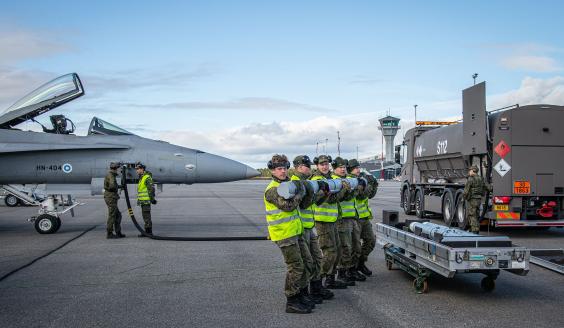
– We applied the same principle with the Hornet fleet back when the MiG and Draken trained service men were conversion trained to work with the Hornet. The premise still remains that conversion training of service men and women will start roughly a year and a half after the onset of training in Finland, around the turn of 2027 and 2028.
Full operational capability to be achieved in phases
With the introduction into service of the F-35 capability, the Finnish Defence Forces will have many vacancies in F-35 operations - about 120 new jobs will be created. Roles related to the F-35 system will open in all personnel categories with an emphasis on military positions in other words officers, non-commissioned officers and officer specialists. These positions include jobs in aircraft maintenance as well as security, intelligence and software. Operator, maintenance and development roles will be available for example with mission support and command and control systems. Some of the positions have already been filled, and more will become available in the next few years.
When the first F-35 fighter aircraft arrive in Finland in the latter half of 2026, the phase of the FINAF’s simultaneous operation of the F/A-18 and F-35 fleet begins. Major General Keränen sees that in operating two fleets side by side the Air Force will benefit from the strengths of both types.
– I think we can get more out of the Hornet as well when we can tap into the F-35 capabilities when operating the Hornet. As a NATO member we must realise that we can get more out the Hornet already now that we may have Norwegians, Danes, Americans and the Dutch here to support us. It’s a big deal as it makes also our Hornets better.
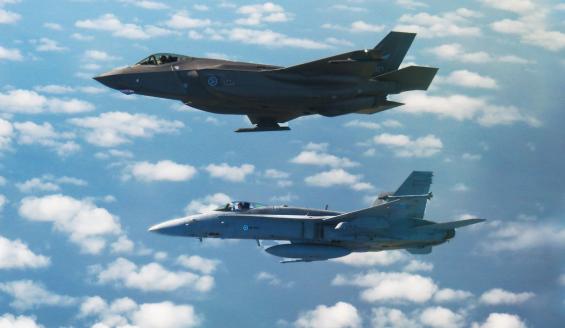
Towards the end of the decade the Finnish Defence Forces will see the launch of other new air defence capabilities in addition to the F-35 when the Navy introduces the Pohjanmaa class multi-role corvettes and the Army the long-range air defence system, David’s Sling. Apart from the F-35, the FINAF integrated intelligence, surveillance and command and control system is another capability that will develop significantly. The system can, for example, fuse surveillance data from the above-mentioned systems and utilise it for their real-time fire control. The FINAF integrated intelligence, surveillance and command and control system, as its name implies, will enhance its different intelligence, surveillance and C2 components’ capabilities.
Integration of F-35 capability proceeds step-by-step.
– We are moving on in phases. For the next three years we’re working to ensure that we’ll have the F-35 initial operational capability in the beginning of 2028. This contains many intermediate phases. And from 2028 onward, the aim for the next three years is to achieve full operational capability.
Upgrades of F-35 weapons and capability on the horizon
The procurement of F-35 weapons has been divided between several years so that the Finnish Defence Forces has the ability to purchase the latest versions of the weapon types. Most recently, Defence Minister Antti Häkkänen authorised the Defence Forces to procure radar-seeking AARGM-ER missiles for the F-35 fighter aircraft.
– We practically have now completed procurement decisions on the weapon types to be acquired for our F-35 fighters. As for our F-35 acquisitions, we have - with the Design-to-Cost principle - until the year 2035 to procure the final items. Hence, we will be able to complement the weapons suite until 2035 with for example the upgraded versions of the weapon types. What remains of the budget will be used for additional weapons procurement, Keränen says.
The Finnish F-35 multirole fighters will be manufactured in series of the 17–22 Block 4 version. This is the fighter’s system upgraded version 3 - in other words the Technology Refresh (TR)-3 configuration.
– The multinational F-35 programme’s Block 4 TR-3 production version’s completion and the related software versions have been slightly delayed which is why upgrades or so-called retrofits are expected for some FINAF F-35 fighters. With these retrofits, the entire Finnish F-35 fleet will be upgraded for certain physical components and system updates to the Block 4 series, on which Finland signed the procurement contract. The retrofits are planned to be installed in the 2030s.
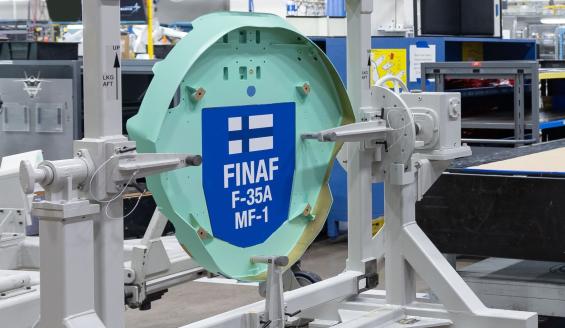
The Finnish Air Force will use the F-35 capability until the 2060s. While in service with the FINAF, the F-35 will undergo periodic life-cycle upgrades and modifications. The Hornet fleet has had two Mid-Life Upgrades (MLUs). The MLUs have ensured that the fleet sustains its relevance in respect to the threat of the operating environment during the fleet’s total planned life-cycle. The F-35 can be expected to undergo regular small upgrades as well as major ones every ten years or so.
– The Hornet has had two mid-life upgrades and several programme updates. As for the F-35, the system development and upgrades tend to be more continuous - so no major work all together but something all the time. We can say that once in a decade, the F-35 will have a more extensive upgrade, including new components: displays, graphics processing units, computers, and appliances, such as a defensive aids system. For the life-cycle development, the F-35 Programme budget has allocated two billion euros in the 2021 currency value.
NATO, F-35 user community and Nordic Countries
The FINAF Commander sees the F-35 user community to reinforce the NATO and European nations’ deterrence and defence. Apart from Finland, currently in Europe the United Kingdom, Italy, the Netherlands, Denmark, Norway, Belgium, Poland, Switzerland, Germany, Czechia, Greece and, as the newest member, Romania belong to the F-35 user community, i.e. operate F-35 fighters or have signed a procurement contract for F-35 fighter aircraft.
NATO, the F-35 user community and the Nordic Countries have profound common interests. In NATO and the Nordics, a hot topic today is the cross-servicing concept which aims for an approach that enables different nations’ fighter fleet to be supported by airfields outside their own territory.

– The F-35 user community feels strongly about promoting aircraft cross servicing, and this is not limited to the F-35 users as NATO has wider interests to enable cross servicing between different types of aircraft. Practical training of this has already begun in the Finnish Air Force as this fall Germany attended Baana 24 exercise in Rovaniemi with their Eurofighters and Finns learned how to refuel them. In other words, some concrete steps have already been taken.
The collaboration with the F-35 user group deepened immediately after the signing of the first procurement contracts when Major General Keränen first attended the F-35 nations’ Air Chief meeting in spring 2022. The FINAF commander recounts his participation in several discussions on lessons identified and lessons learned with the other F-35 nations’ air chiefs. All in all, information exchange has been open and Finns have received pointers for operating the F-35 from countries where the fleet is already in service.
– Observations on operating the F-35 have been openly shared in the F-35 user community. Sharing is beneficial and we appreciate the pointers for planning our own operations. It’s great to be part of this community.
Nordic cooperation has also become visible in the Finnish Air Force for example in education and training. Since autumn 2023, the Air Force Academy has had three Norwegian student pilots and one flight instructor. The FINAF commander would like the training cooperation to continue. Expectations on a certain benchmarking of the training quality also exist - when the Finnish trained Norwegian students leave after Hawk training for the United States to attend F-35 training as per the Royal Norwegian Air Force’s programme, it will be seen how their skills compare to those of the Norwegian student pilots who have received their training in the United States.
– One of the best things about the Norwegian students’ training in Finland and the United States is that they learn to know pilots from many different countries. Friendships are formed that makes cooperation natural for them right now and also later in their careers.
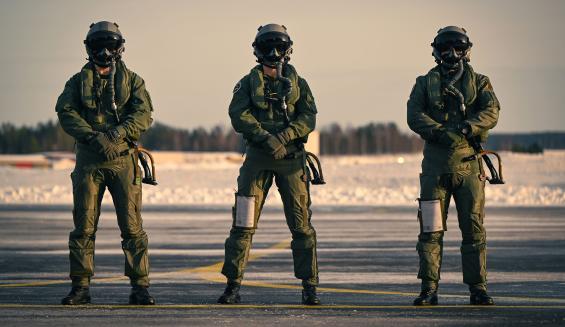
Regarding the collaboration of the F-35 user nations, Major General Keränen mentions that appreciation for Finnish know-how can be noticed. According to him, representatives of other countries have acknowledged seeing Finns do relevant things and with the right attitude. Another sign of appreciation, Keränen continues, is the fact that Finns are much desired collaboration partners.
– If they want to have deep cooperation with us, we could think it means we’ve been working well. Also based on the comments we’ve received, we are doing the right things. Our feet-on-the-ground attitude may have an impact and the fact that we have taken the threat posed by Russia seriously. We are not here to play games but to defend our country if the need arises.
Retiring commander pleased to transfer into reserve
Major General Keränen is now in his last week of active duty service. The commander of the Finnish Air Force changes at the turn of the month: the retiring commander transfers into the reserve and Brigadier General Timo Herranen takes over. Major General Keränen is happy to hand the command to Brigadier General Herranen. The Finnish Air Force is a spirited, capable service and its future looks bright.
– You do know that the career of an officer is a progression of stages and you have to live with it. This is a suitable time for a change of command as the F-35 Programme and its initial training preparation are off to a good start and we are integrated into the NATO command and control system. Herranen will then oversee in his command that we proceed systemically towards the initial operational capability phase and standardise operational air policing activities in NATO. Everything has gone forward as scheduled - both the F-35 Programme and our integration into the NATO functions, Keränen says.
Major General Keränen has a long career in the Finnish Air Force behind him. He recounts memories looking back at his career.
– When I recall memorable moments along my career, being selected to become a fighter pilot comes to mind first. My first flight on the MiG-21BIS was unforgettable and so was the initial Hornet training in the United States in the mid-1990s and starting HN operations in Finland. Then came international exercises, which were a big deal. I remember serving as Finland’s first Mission Commander in an exercise in the Netherlands in 2001. TACEVAL (Tactical Evaluation programme for the NATO Readiness Force) was a remarkable four-year project that brought Finland a great deal of positive publicity and appreciation within the NATO members. Being the commander of the Air Combat Centre, squadron commander and air wing commander was great and then this fighter programme that I have been part of since the year 2017. I have had varied and fascinating roles. Of course, the latest duty in my mind has been integration into NATO and being invited to move from the side table to sit at the same table with the NATO air chiefs. Those are some to mention but it’s hard to pick just one highlight of my career. Well, I’d say having been selected to fly fighter aircraft and later to do so many interesting jobs.
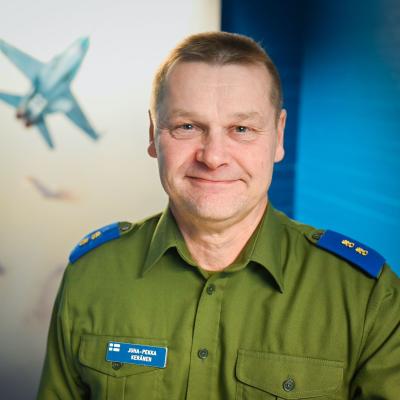
In other words, there are more than enough experiences and memories gained during the versatile career. From active duty service Keränen believes he will miss the FINAF community and flying.
– It is the close-knit community spirit of this workplace that I will definitely miss in all this. The Finnish Air Force is a fairly close, small service where mutual trust is strong and everyone knows each other. You can be yourself and not try to fit in a predetermined mold. From active duty service, I will also miss flying. I will fly the Hornet for one last time on Saturday 30 November.
Major General Keränen has no big plans yet for his retirement.
– I haven’t given it much thought - a pursuit of something light in moderation - maybe working out and other hobbies I haven’t had much time for.
Lastly, we must ask Keränen for his opinion on what we should call the new FINAF fighter aircraft. Will it be a JF or an F-35 flying alongside the Hornet?
– I tend to call the Hornet HN all the time so in my opinion it will be JF which is a completely relevant name to use. JF and Joint Fighter are very suitable as we see that the system produces Defence Forces-wide capabilities. That’s why JF was selected as the fleet’s designation. Lightning II doesn’t quite fit in my mouth. But it’s no big deal, you can call it whatever. You can talk about the JF, Joint Fighter or the F-35.
